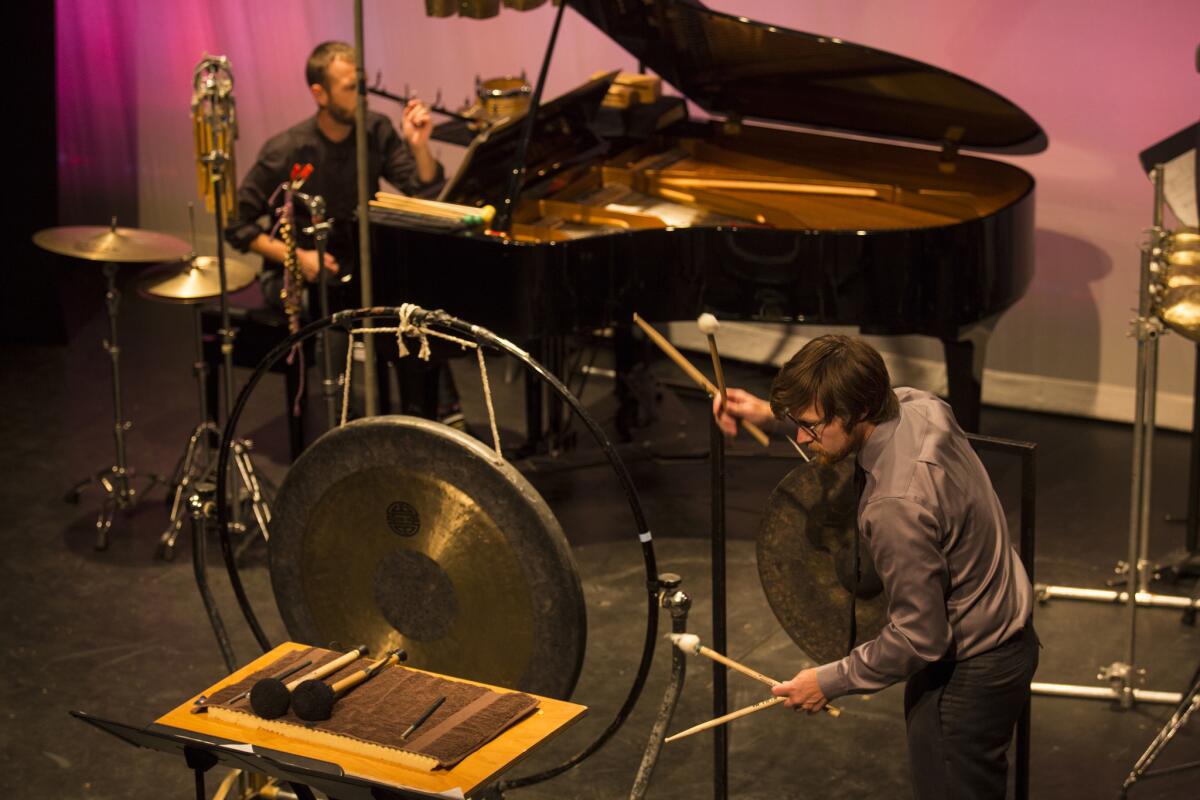Column: Bernstein and Stockhausen in the age of anxiety: How 1950s music feels remarkably prophetic

Musicologist and critic James Wierzbicki has titled his illuminating new book on American music of the 1950s “Music in the Age of Anxiety,” revealing a decade uncomfortably like our own. It was a time when bland commercialism badly attempted to cover up an atmosphere of great social change, the disruptive beginning of the digital age and the Cold War threat of Earth’s annihilation hanging over everything.
Last week, there were two exceptional back-to-back performances of prophetic major works from the late ’50s — Leonard Bernstein’s “West Side Story” at the Hollywood Bowl and Karlheinz Stockhausen’s “Kontakte” at the Boston Court Performing Arts Center in Pasadena. Everyone knows Bernstein’s update of “Romeo and Juliet” to New York ethnic gang warfare as an all-American icon that has never stopped reminding in the nearly 60 years since its Broadway premiere of our inadequate progress in the areas of race relations. It was personal for Bernstein, whose career began during World War II and who knew, as a Jew, he might have had a very different fate had his father not immigrated to America.
Stockhausen’s avant-garde work for piano, percussion and four-channel, surround-sound electronic tape comes from another part of the world and mind-set, but it is the product of an equally anxious musician. Rather than directly confronting issues of race and assimilation, the German composer reacted to the greatest horrors of racial persecution in modern history as a traumatized artist who was coerced into Hitler Youth as a boy and whose mother was the first mentally ill patient euthanized by the Nazis for what they saw as her uselessness to society.
Unlike the emotionally demonstrative Bernstein, Stockhausen dealt with his anxiety through distrust of emotion. He required new sounds, new rhythms, a new music without past connotations. He desired a newly scientific solid musical ground, one in which sound was reduced to its physical properties and then reassembled into something offering radically new experiences.
Stockhausen and Bernstein didn’t have much to do with each other. Stockhausen was horrified and fascinated by Bernstein. In a gloriously impolitic letter suggesting some of his pieces that Bernstein might conduct with the New York Philharmonic, Stockhausen in one breath confessed to angrily walking out of a performance offended by Bernstein’s great show of ego (it took one to know one) and in the next comparing Bernstein’s soul to Mozart’s. Showing that letter to everyone he knew, Bernstein seemed appalled and gratified by attention from the most celebrated visionary of the era. Always concerned that he be up to date, Bernstein made a point of catching Stockhausen’s latest works when the German came to New York.
The revelation, though, in hearing “West Side Story” and “Kontakte” in brilliantly knowing performances is not how different they sound, these works written for radically different audiences and in radically different musical languages, but what they have in common and what that means for us now. The essential connection is that both Bernstein and Stockhausen realized that we cannot go on repeating the same worn-out vocabulary. When dealing with the anguish of the modern world, new musical languages are necessary.
In Bernstein’s case, that was an elevation of Broadway, a broadening of musical technique of popular song to allow for corrective complexity and pronounced operatic expression, along with richer understanding of world music (in this case Latin dance), all of which Gustavo Dudamel, in his Bowl performance with the Los Angeles Philharmonic and a fine cast (performing again Tuesday night), has been able to bring out with remarkable naturalism and immediacy.
Stockhausen’s language, on the other hand, when “Kontakte” premiered in 1960, was invented and seemingly artificial. No one had ever heard anything like this 35-minute score, one of the first pieces to successfully combine acoustical instruments with electronics.
“Kontakte” is built around taped recordings of the most advanced electronic sound-generating equipment of the time. The pianist and percussionist must synchronize in places to the fraction of a second, as Todd Moellenberg and Ryan Nestor respectively did with striking virtuosity and theatricality in their Boston Court performance Saturday organized by the People Inside Electronics music series.
The piece can be an assault on the listener and next to impossible to make sense of. It is made with what Stockhausen called “moment form,” where musical events, like life, are lived minute to minute. It is called “Kontakte” for a reason. The “contacts” are electrical and they are also as physical as football when piano and percussion interact with what is coming out of loudspeakers, as if this were a visceral confrontation between the digital and analog worlds.
The actual electronic sounds are their own experimentation with the interaction between digital and analog, with the equivalent between particle and wave. In one spectacular moment, halfway through the tape, Stockhausen slows down the frequency of a sine wave until it turns into beats. Pitch becomes rhythm. All of this happens as sounds also move through space as they never had before (and seldom have so effectively since), which may be as close as we can come to the production of a four-dimensional art form through which space-time can actually be felt.
By allowing us to tangibly sense nature as a unity, Stockhausen winds up creating something shockingly emotional. The impression I got from the crowd at Boston Court was that of being simultaneously overwhelmed and amazed. On many faces were what appeared to be awestruck “aha!” smiles.
“West Side Story” is a tragedy that, in an ideal performance, raises consciousness of how to make the world better. “Kontakte” is a kind of tragedy too. What with all those pummeling electronic explosions and performers put through the wringer, the war still rages in Stockhausen. But in so doing, he too creates an unexpected perspective of a world out there bigger than our own concerns, a call to our better selves.
We have much to learn from how Bernstein and Stockhausen dealt with their ’50s: not relying on the nostalgic old formulas that lie behind so much new music and supposedly new digital thinking, none of which is nearly as new as “West Side Story” and “Kontakte.”
More to Read
The biggest entertainment stories
Get our big stories about Hollywood, film, television, music, arts, culture and more right in your inbox as soon as they publish.
You may occasionally receive promotional content from the Los Angeles Times.











